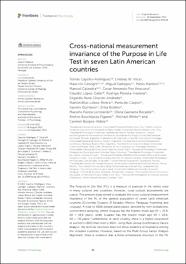Mostrar el registro sencillo del ítem
Cross-national measurement invariance of the Purpose in Life Test in seven Latin American countries
| dc.contributor.author | Caycho-Rodríguez, Tomás | es_ES |
| dc.contributor.author | Vilca, Lindsey W. | es_ES |
| dc.contributor.author | Cervigni, Mauricio | es_ES |
| dc.contributor.author | Gallegos, Miguel | es_ES |
| dc.contributor.author | Martino, Pablo | es_ES |
| dc.contributor.author | Calandra, Manuel | es_ES |
| dc.contributor.author | Rey Anacona, Cesar Armando | es_ES |
| dc.contributor.author | López-Calle, Claudio | es_ES |
| dc.contributor.author | Moreta-Herrera, Rodrigo | es_ES |
| dc.contributor.author | Chacón-Andrade, Edgardo René | es_ES |
| dc.contributor.author | Lobos-Rivera, Marlon Elías | es_ES |
| dc.contributor.author | Del Carpio, Perla | es_ES |
| dc.contributor.author | Quintero, Yazmín | es_ES |
| dc.contributor.author | Robles, Erika | es_ES |
| dc.contributor.author | Panza Lombardo, Macerlo | es_ES |
| dc.contributor.author | Gamarra Recalde, Olivia | es_ES |
| dc.contributor.author | Buschiazzo Figares, Andrés | es_ES |
| dc.contributor.author | White, Michael | es_ES |
| dc.contributor.author | Burgos-Videla, Carmen | es_ES |
| dc.date.accessioned | 2023-01-25T15:53:12Z | |
| dc.date.available | 2023-01-25T15:53:12Z | |
| dc.date.issued | 2022-09-16 | |
| dc.identifier.uri | https://hdl.handle.net/20.500.13053/7689 | |
| dc.description.abstract | “The Purpose in Life Test (PIL) is a measure of purpose in life widely used in many cultures and countries; however, cross-cultural assessments are scarce. The present study aimed to evaluate the cross-cultural measurement invariance of the PIL in the general population of seven Latin American countries (Colombia, Ecuador, El Salvador, Mexico, Paraguay, Argentina, and Uruguay). A total of 4306 people participated, selected by non-probabilistic convenience sampling, where Uruguay has the highest mean age (M = 41.8; SD = 16.6 years); while Ecuador has the lowest mean age (M = 24.6; SD = 7.8 years). Furthermore, in each country, there is a higher proportion of women (>60%) than men (<40%). Using Multi-Group Confirmatory Factor Analysis, the factorial structure does not show evidence of invariance among the included countries. However, based on the Multi-Group Factor Analysis Alignment, there is evidence that a three-dimensional structure of the PIL (Meaning of existence, Freedom to make meaning in daily life and Will to find meaning in the face of future challenges) is the same in the participating countries. Results based on item response theory indicate that most PIL items can significantly differentiate responses according to the level of life purpose. In addition, people with low life purpose will tend to choose the lower response alternatives on the PIL; while people with higher life purpose will choose higher response alternatives. The findings indicate that the PIL has the potential to increase knowledge about how people conceive and experience their purpose in life in different countries. “ | es_ES |
| dc.format | application/pdf | es_ES |
| dc.language.iso | eng | es_ES |
| dc.publisher | Frontiers Media S.A. | es_ES |
| dc.rights | info:eu-repo/semantics/openAccess | es_ES |
| dc.rights.uri | https://creativecommons.org/licenses/by/4.0/ | es_ES |
| dc.subject | "measurement invariance, cross-cultural, purpose in life, Latin American, Analysis Alignment " | es_ES |
| dc.title | Cross-national measurement invariance of the Purpose in Life Test in seven Latin American countries | es_ES |
| dc.type | info:eu-repo/semantics/article | es_ES |
| dc.identifier.doi | https://doi.org/10.3389/fpsyg.2022.974133 | es_ES |
| dc.type.version | info:eu-repo/semantics/publishedVersion | es_ES |
| dc.publisher.country | CH | es_ES |
| dc.subject.ocde | http://purl.org/pe-repo/ocde/ford#3.03.00 | es_ES |
Ficheros en el ítem
Este ítem aparece en la(s) siguiente(s) colección(es)
-
SCOPUS [380]


